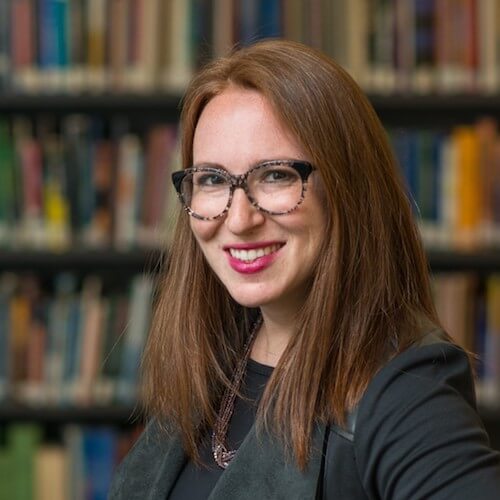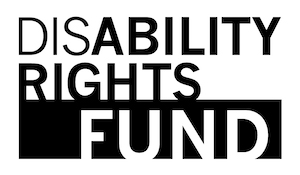What Funders Need to Know About Disability-Inclusive Grantmaking: Disability Rights Fund

This interview is a Q&A with Jen Bokoff, Director of Development at the Disability Rights Fund and the Disability Rights Advocacy Fund. It has been lightly edited for clarity.
Can you share a bit about your work/the work of your organization?

The Disability Rights Fund and the Disability Rights Advocacy Fund support persons with disabilities around the world in building diverse movements, ensuring inclusive development agendas, and achieving equal rights and opportunity for all. The basis of our work is “nothing about us without us;” we operate with a participatory grantmaking structure, with persons with disabilities at all levels of our structure including our staff, board, and grantmaking committee. Since we launched in 2008, the funds have awarded 1,387 grants to 371 disabled persons organizations (DPOs) in 37 countries totaling nearly $38M USD.
My role is to fundraise in support of our work. Every year, we aim to regrant 60% of funds raised, with an additional 22% of our budget earmarked for programmatic costs—including technical assistance, grantee convenings, and advocacy—of staff and grantees at global and regional levels. The remaining funds are used to support operations.
Why is it so important for grantmakers to center disability inclusion in their work?
I’ve been in a lot of conversations, Twitter threads, conference sessions, and strategy development processes in philanthropy that focus on diversity, equity, and inclusion (DEI) at foundations. Persons with disabilities are seldom included in the scope of these discussions, let alone in the scope of foundations’ work. This is frankly confusing given that one in every seven people worldwide has a disability. No matter what you fund, I guarantee that your constituency has persons with disabilities in it. (And, if you think it does not, I’d encourage you to look closer.)
Just as persons with disabilities are often marginalized in conversations about DEI, they are often marginalized too in programs, policies, and practices. (This includes the grantmaking processes and governance structures for many foundations.) From supporting after-school programs to climate change initiatives, it is essential to center disability inclusion. Without doing so, efforts become exclusionary to those for whom the effort is accessible. Further, you contribute to the marginalization of persons with disabilities. Hopefully, missing one in seven people is not a consequence you’re comfortable with.
What would you say to foundations that claim they “don’t fund disability?” What do funders need to know about how disability intersects with their primary funding areas (e.g. health equity, racial equity, social justice, education, the arts)?
“Why not?”
I’ve never heard a compelling answer to this question. Instead, the answers feel apologetic and hypocritical, taking the form of “we need to focus on other populations” or the more honest “we don’t really know how to do it well.” There isn’t a good answer, because persons with disabilities are core stakeholders to every single population or issue focus for funding. You don’t solve equity issues by leaving out another marginalized group.
If you’re addressing racial equity, recognize that Black, Indigenous, and people of color with disabilities are even more marginalized than Black, Indigenous, and people of color without disabilities. If you’re working on a safe sex initiative, recognize that LGBTQI persons with disabilities are even more marginalized than LGBTQI persons without disabilities. If you’re funding an educational initiative for womxn in Rwanda, recognize that womxn with disabilities may face access challenges that womxn without disabilities won’t face. Disability intersects with every other identity. Funding specifically at this intersection is necessary to advancing a wide range of movements and outcomes. Why would you drive 85% of the way to a destination only to stop 15% short? Additionally, funding disability brings persons with a wide range of experiences, identities, needs, and perspectives into your work. This enables more nuanced, strategic, and thoughtful solutions and impact.
As a development director for a disability-focused organization, what do you most want funders to know?
Let’s start with the data: only 2% of human rights funding supports persons with disabilities. This is not enough. Please use this data point to unlock additional funding within your organization. New funding does not need to compete with your existing portfolios; think about how supporting persons with disabilities will instead strengthen those portfolios. (And I promise, brilliant, underfunded DPOs and initiatives that sit at the intersection of the issues you fund and disability are out there!)
Before I came to DRF/DRAF, I was working at Candid. One of my final responsibilities was monitoring COVID-19 response efforts across philanthropy. When we’d look at data based on population, the previous data point held true; very few funds in the wake of COVID-19 have been directed to persons with disabilities. However, persons with disabilities are facing higher risk and challenges, and also hold undervalued knowledge about accessibility and chronic health issues that is suddenly in high demand. Now is an excellent time to start channeling resources to disability-focused organizations, and especially disability-led organizations. Lived experience is critical when figuring out how to do address unknowns like the pandemic.
At DRF/DRAF, we can help you reach the organizations around the world that are building power and opportunity for persons with disabilities. You might not know where resources are needed most, but our in-country staff, networks, and grantmaking committee members do. Most of our grantmaking happens as part of a pooled fund, contributed to by donors around the world who want to support disability rights but perhaps don’t have the reach or capacity themselves. I hope this is just the beginning of conversations we can have together.
Do you have any recommended resources to share with funders?
My biggest plea is that you read enough so that you can have meaningful meetings with partners and grantees in the disability rights space. They shouldn’t spend half or more of a meeting doing basic disability awareness.
Since I’m so new to this role, I’ve been consuming some fantastic content shared by others. This is only a starting point, but you can dig in with:
- Crip Camp: A documentary about a groundbreaking summer camp and the disability activists that came out of it, who helped to build a movement for disability rights in the United States.
- Disability Visibility: A compendium of first-person stories by persons with disabilities, and part of the broader Disability Visibility Project, which is an online community dedicated to creating, sharing, and amplifying disability media and culture.
- CRPD: The Convention on the Rights of Persons with Disabilities is essential to read up on, both to understand how it came to be and what has happened since. I appreciated reading the archived minutes from when it was in development to better understand who was at the table, and how.
- Twitter: There are a lot of people tweeting about disability, and it’s a great way to listen and learn. Follow #CripTheVote to understand the issues that persons with disabilities here in the U.S. are tuning into. (Hint, it’s not a monolith, and politics are all over the map.)
- DRF/DRAF Gender Guidelines: These guidelines build on our work to lift up marginalized voices in the disability community and to address the intersections of rights.
- Donor’s Guides to Inclusion: These three publications either featured or authored by DRF/DRAF offer practical tools and frameworks for inclusion of persons with disabilities in your work.
To contact Jen, please email: jbokoff@disabilityrightsfund.org
